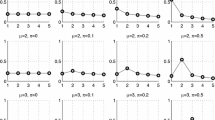Abstract
In this paper, we propose preliminary estimators for the parameters of a mixture distribution introduced for the analysis of ordinal data where the mixture components are given by a Combination of a discrete Uniform and a shifted Binomial distribution (cub model). After reviewing some preliminary concepts related to the meaning of parameters which characterize such models, we introduce estimators which are related to the location and heterogeneity of the observed distributions, respectively, in order to accelerate the EM procedure for the maximum likelihood estimation. A simulation experiment has been performed to investigate their main features and to confirm their usefulness. A check of the proposal on real case studies and some comments conclude the paper.
Similar content being viewed by others
References
Agresti A (2010) Analysis of ordinal categorical data. Wiley, Hoboken
Biernacki C, Celeux G, Govaert G (2003) Choosing starting values for the EM algorithm for getting the highest likelihood in multivariate Gaussian mixture models. Comput Stat Data Anal 41: 561–575
Breen R, Luijkx R (2010) Mixture models for ordinal data. Soc Methods Res 39: 3–24
Capecchi S, Piccolo D (2010) Modelling approaches for ordinal data: the case of Orientation Service evaluation. Quaderni di Statistica 12: 99–124
D’Elia A, Piccolo D (2005) A mixture model for preference data analysis. Comput Stat Data Anal 49: 917–934
Gourieroux C, Monfort A (1995) Statistics and econometrics models. Cambridge University Press, Cambridge
Greene WH, Hensher DA (2003) A latent class model for discrete choice analysis: contrasts with mixed logit. Transp Res B 37: 681–689
Grün B, Leisch F (2008) Identifiability of finite mixtures of multinomial logit models with varying and fixed effects. J Classif 25: 225–247
Iannario M (2008) Selecting feeling covariates in rating surveys. Statistica Applicazioni VII: 25–44
Iannario M (2010) On the identifiability of a mixture model for ordinal data. Metron LXVIII: 87–94
Iannario M (2012) Modelling shelter choices in ordinal data surveys. Stat Methods Appl 21: 1–22
Iannario M, Piccolo D (2009) A program in R for cub models inference, version 2.0. http://www.dipstat.unina.it/CUBmodels1/
Iannario M, Piccolo D (2010) A new statistical model for the analysis of customer satisfaction. Quality Technol Quant Manag 7: 149–168
Iannario M, Piccolo D (2012) cub models: statistical methods and empirical evidence. In: Kenett RS, Salini S (eds) Modern analysis of customer surveys: with applications using R. Wiley, Chichester, pp 231–258
Karlis D, Xekalaki E (2003) Choosing initial values for the EM algorithm for finite mixtures. Comput Stat Data Anal 41: 577–590
Lindsey JK (1996) Parametric statistical inference. Clarendon Press, Oxford
McCullagh P (1980) Regression models for ordinal data (with discussion). J R Stat Soc B 42: 109–142
McCullagh P, Nelder JA (1989) Generalized linear models, 2nd edn. Chapman & Hall, London
McLachlan G, Peel GJ (2000) Finite mixture models. Wiley, New York
Nettleton D (2009) Testing for the supremacy of a multinomial cell probability. J Am Stat Assoc 104: 1052–1059
Pardo L (2006) Statistical inference based on divergence measures. Chapman & Hall/CRC, Boca Raton
Parzen E (1962) On estimation of a probability density function and mode. Ann Math Stat 33: 1065–1076
Piccolo D (2003) On the moments of a mixture of uniform and shifted binomial random variables. Quaderni di Statistica 5: 85–104
Piccolo D (2006) Observed information matrix for MUB models. Quaderni di Statistica 8: 33–78
Piccolo D, D’Elia A (2008) A new approach for modelling consumers’ preferences. Food Quality Preference 19: 247–259
Rao CR (1973) Linear statistical inference and its applications, 2nd edn. Wiley, New York
Silverman BW (1993) Density estimation for statistics and data analysis. Chapman & Hall, London
Titterington DM (1980) A comparative study of kernel-based density estimates for categorical data. Technometrics 22: 259–268
Wang M, van Ryzin J (1981) A class of smooth estimators for discrete distributions. Biometrika 68: 301–309
Wedel M, DeSarbo WS (1995) A mixture likelihood approach for generalized linear models. J Classif 12: 21–55
Author information
Authors and Affiliations
Corresponding author
Rights and permissions
About this article
Cite this article
Iannario, M. Preliminary estimators for a mixture model of ordinal data. Adv Data Anal Classif 6, 163–184 (2012). https://doi.org/10.1007/s11634-012-0111-5
Received:
Revised:
Accepted:
Published:
Issue Date:
DOI: https://doi.org/10.1007/s11634-012-0111-5




